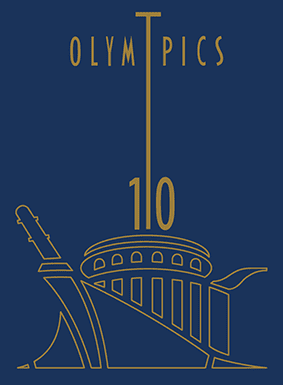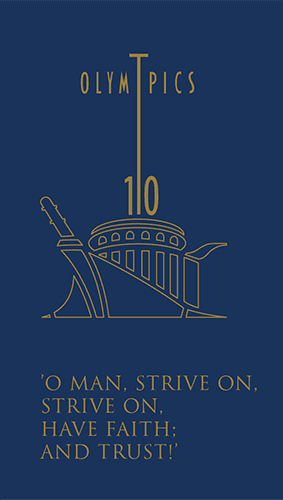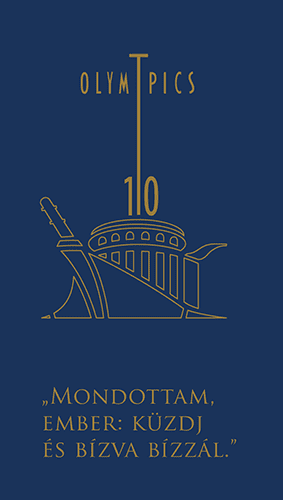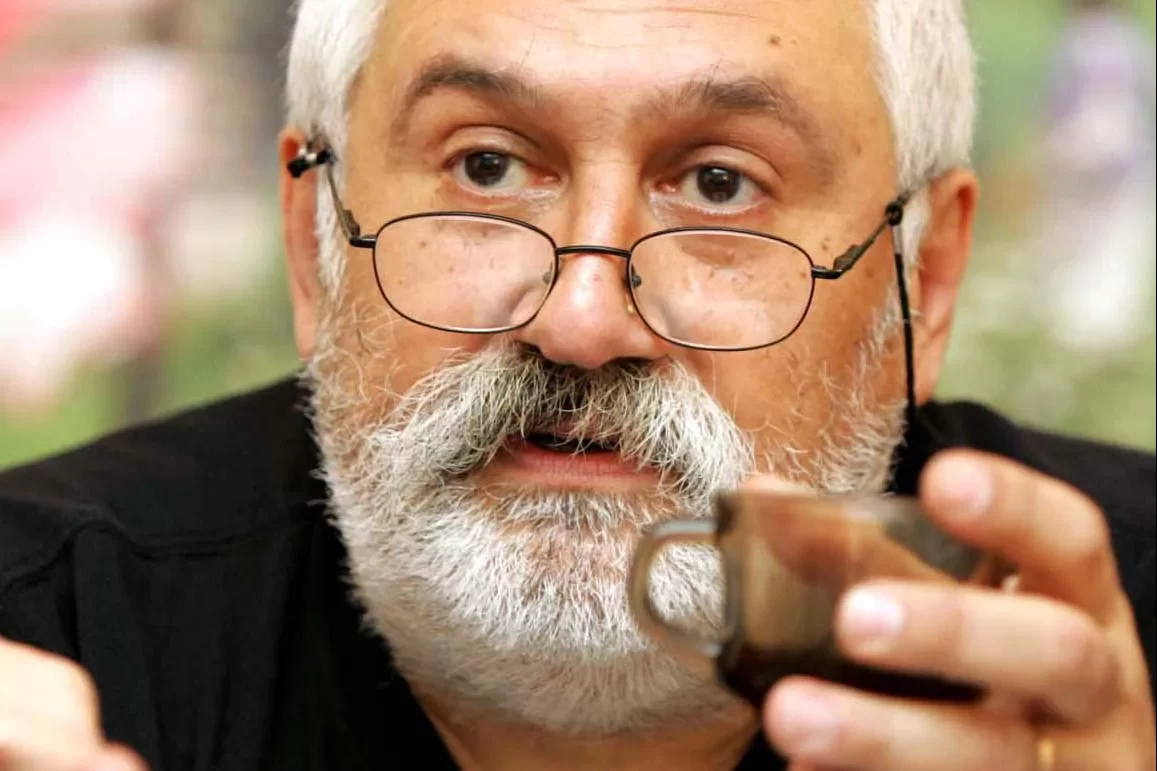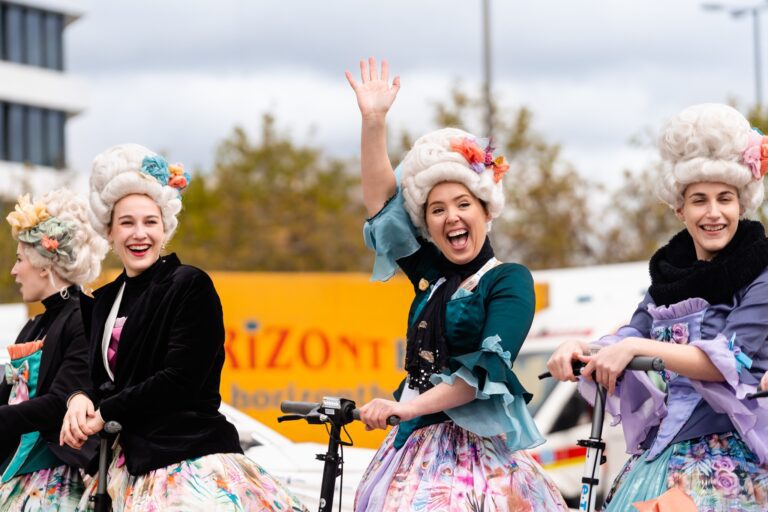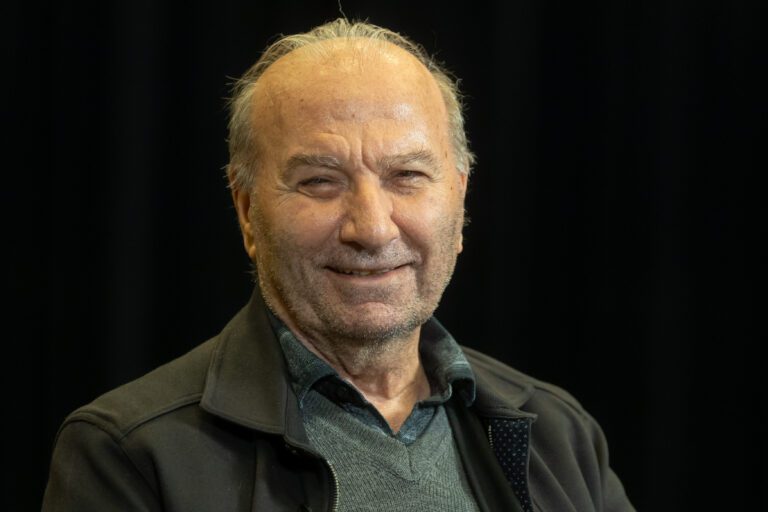The author of the article is George Banu (b. 1943) Romanian-born theatre critic, theatrologist, professor of Theatre Studies at Sorbonne Nouvelle, Honorary President of the International Association of Theatre Critics, who has lived in Paris since 1975. Five of his books have been published in Hungarian by Koinónia Kiadó (Koinónia Publishing House), Cluj-Napoca, Romania. He moderated the roundtable discussion entitled Contemporary Scenography: Crisis and Metamorphosis at MITEM II in 2015. His essay gives a vivid picture of the characteristic features of the art of Europe wide famous Romanian stage director Silviu Purcărete. His most important stage directions are covered here, with Goethe’s Faust among them, which, in Banu’s opinion, is a synthesis of Purcărete’s lifework so far. This production promises to be one of the greatest sensations at MITEM this year. (On Purcărete’s stage directions in Hungary, see the Helmut Stürmer publication in the present issue).
Purcărete is an independent artist reluctant of belonging to any institution or maintain long-term partnerships. He moves around various stages of the world driven by chance encounters, always looking to motivate a company and complete his mission regardless of the circumstances. A theatrical director quite unafraid of commuting, meeting with unknown companies but always surrounded by his loyal team. They are inseparable. Scenographers Helmuth Stürmer or Dragoș Buhagiar and the composer Vasile Sirli are always by his side because Purcărete insists on relying on this time-proven core team. Providing each other with mutual inspiration, they immerse themselves to production after production, from St Petersburg to Sibiu, from Moscow to Porto or Ljubljana. Purcărete is a free artist, but not a lonesome one.
The magic rulebook for choosing plays
Purcărete has a limited love affair with words and an endless one with pictures. His choice of plays may well be driven by the desire for variety, but his choices are still aligned along two reconcilable strands: one is the use of abridged, concentrated plays stripped to their core, while the other is the adaptation of literary texts, intruders from a world other than the theatre – from Ovid to Tolstoy. He is a two-faced Janus, whose choices fall into two categories, without either of them gaining dominance. Following the Molière’s The Imaginary Invalid he turned to the Napoleonic saga War and Peace and after the playful interlude of Moliendo Café delected himself with a comedy by Labiche. And so it goes on, without him becoming enslaved to anything. Still, the shining beacon of his oeuvre remains Faust, this adventure of epic proportions that began in Sibiu and which has been the defining element of the international festival there for a decade now. Faust encapsulates Purcărete’s aesthetic and while the performance may have changed and evolved over time, it continues to be the cornerstone of his art, like The Servant of Two Masters for Strehler, the Mahabharata for Brook, the Antique Trilogy for Șerban, Oresteia for Stein, and so on. All of these are essential performances carrying a specific identity while also validating a journey.
On the other hand, Purcărete invariably returns to Shakespeare, never giving up on or forgetting him entirely: this gravitational pull is a constant of his career. As a young director in Communist Romania, he created an unforgettable Richard III., with the protagonist Stefan Iordache delivering a mesmerizing and complex king figure. Purcărete abhors oversimplification, gross disparagement and summary judgement. He later directed two plays at the Marin Sorescu Theatre in Craiova, at turn tear-jerking and grotesquely savage, both of which brought him European fame. These were Titus Andronicus and King Ubu, the latter incorporating scenes from Macbeth.
This is a dazzling display of serial murders set on a white canvas accompanied by Mozart’s Piano Concerto No. 24 and one of the most poetic theatrical performances I ever had the chance to see. Unfortunately I did not have the opportunity to see his Troilus and Cressida at the Katona József Theatre, widely believed to be one of the best adaptations for scene. Purcărete returned time and again to A Midsummer Night’s Dream, delving on the night scenes – not so much in the forest, but rather the candlelit, magnificent inner spaces of the human consciousness. The lovers are lost and Puck, the almighty servant appears in a different form every time, making amends for his missteps first as a wild prankster, later as a humble slave. What the audience took home from this was the vision of a convoluted “dream”….
Purcărete shared his “Dreams” every now and again and as a fortunate witness I can testify that these always left a lasting impression. He devoted much time to comedies such as Twelfth Night and he recently revisited it at the National Theatre in Budapest. The latter performance is a veritable meditation on the link between characters and audience, the inevitable symbiotic relationships of theatre: is theatre not the art of perpetually becoming someone else and then still returning to our own selves? The performance gave ample proof of that through the seemingly trivial, yet masterful display of the actors’ tools: makeup, costume changes, special effects. Oscar Wilde said that theatre seduces us by “flooding us with the imaginary”, but this “falsehood” can only dazzle us through emotion.
Purcărete is familiar with the Shakespearian vistas and in the last of the plays, The Tempest, he paused just like Prospero – a Faust precursor, if you like – did on the black sand of his imaginary island as melancholy sage. Another such pivotal point was the ruthless debate in the centre of Julius Caesar, delivered as a political drama. Arguably, his greatest staging of Shakespeare was Troilus and Cressida, in which he succeeded in blending the grotesque with the playful, scathing satire with desolate elegy while also capturing the essence of Shakespearian “totality of contradictions” as described by Peter Brook. He did, however, let two opportunities pass by, because – as he later confessed in private – “I don’t like ubiquitous plays for which I could only offer yet another variation”. Thus we are still waiting for his version of King Lear and Hamlet. One of his greatest fascinations, though, is turning comedies into tragedies and the other way around. This, for him, is the definition of the art of stage direction, the kind of work that will confuse and flabbergast anyone inclined to pigeonhole Shakespeare’s greatest plays.
Purcărete is no stranger to Greek drama either: he directed a famous Oresteia performance and an epic Danaides, the latter having met with controversial responses in Europe. The play still did clearly exemplify the director’s concept of attempting to move the choir around while stressing the performances of emblematic Romanian actors in the key roles. Danaides was particularly challenging for Purcărete, because here he blended traditional Greek tragedy with Elizabethan stagecraft. But this unpredictable director whose professional staging is always sensitive to the peculiarities of the companies he works with is also on a permanent search for texts that are either obviously tailor-made for him or, conversely, seemingly ungraspable. As a Ulysses of the stage, he allows himself to be seduced without ever giving up his identity: he wanders from Molière to Labiche to Chekhov, from Pirandello to Beckett or Caragiale, the epitome of Romanian national identity. His choice of plays is a meandering journey.
Purcărete is obviously in love with theatre, but never the slave of any single actor. Of Goethe’s plays he only liked Faust. He treated it as a meditation on the power of the stage, in which theatre is the antithesis of science, a science whose boundaries are witnessed even by the sceptic scientist himself. The disciples of this scientist who sets upon his journey of discovery are modelled after the characters of Kantor’s Dead Class, in a thoroughly contemporary setting, surrounded by state-of-the-art computers in a classroom. Faust – a somewhat perverted entity with his neither male, nor female identity is seduced by Mephistopheles. His reason for abandoning his laboratory is not precisely defined, because Margarete takes multiple forms, snatches him out of his solitude and they embark on Walpurgis-night, give in to the power of the stage and the true flow of life in defiance of its frustrations. The stage curtain is contained within a huge frame, thereby the characters become mythological symbols of contemporary theatre. But one of the performance’s most poignant scenes of utter liberation is the one where Faust – as an old man nearing the end of his days – returns to his cradle that emerges from his coffin. We have come full circle.
While the international theatrical world awaits his next choice of play, Purcărete will complement his journey around the imaginary museum with other experiences gathered during his most travels on more esoteric paths such as the collages of Ovid* or those of various humorists’ texts which will end up as unconventional theatrical performances. But let us not forget his masterpiece, Pantagruel’s Cousin, a silent play that is the essence and synthesis of Purcărete’s theatre or Palilula (Somewhere in Palilula – editor), the motion picture counterpart of Pantagruel. These are, yet again, the works of an artist who will build on the elements of reality only to go beyond them and leave us hesitating in our desire for poetic charm Metamorphoses, based on Ovid’s play, Purcărete is not one to be enslaved by the words he had manipulated, transfigured or transplanted, nor by the words put to the music of composer friend Vasile Sirli. With him, we can always enjoy the sophisticated metamorphosis that progresses from words to tunes, temporarily suspending the authority of the original text in order to reach the shores of murmured chants and lyrical whispers. These are the poetics of a playful body overflowing its original boundaries, a fluid body in love with the sounds beyond, the words that have become hesitant in their meaning. His performances often evoke a saying by his great predecessor, Monteverdi, who was after the very same multi-layered meaning in his Parlar Cantando program.
Chorality and poetic materialism
Purcărete is partial to use chorality in expressing a bustling, mingling world in permanent rearrangement and disarray. This is whole in perpetual motion that can be shaped like putty, demolished like sandcastles and defies overly authoritative rules of construction. On his stage there is no posturing, there are no tableaus, he fascinates us by having everything in motion. He also fascinates us by occasionally presenting a fleeting, “Ubu-like” shadow, discrete hints of a self- portrait, the portrait of an artist who –unlike Hitchcock – only allows his doubles to take centre stage. Purcărete was never more melancholy then in creating the character of Vladimir in his unforgettable rendition of Godot in Sibiu. This Vladimir is a thoroughly defeated and misled figure, whose perpetual expectance of another meeting – as an unfulfilled wish – was born of the fascination of the paradise lost, whose advent he portrays in the light of a heroic herald. In this rendition, Purcărete lets loose his mostly reserved lyrical vein more than ever. He may be stubbornly chaste, but will still deliver the occasional confession!
Purcărete has studied arts– just like his partners, Helmut Stürmer and Dragos Buhagiar – but will never let alien codes dominate the stage. He is very much in love with the specific virtues of the stage and will imagine corporeal beauty through the body’s dialogue with painted canvases or organic matter, subjecting the above to the unfolding of words and the rhythm of the music. His arts background is never extrinsic, it is there only through the harmony of the theatrical components. He is sometimes blamed for truncating texts with extreme prejudice, whereas, in fact – something he doesn’t even deny – he only robs the text of its central role, placing it in the democratic structure of his creation whose elements are equal in value. In this sense, Purcărete can be regarded as the precursor of contemporary “playwrights”, who favour the same unorthodox logic. In his work we can also find vestigial elements of medieval acting, where the written text was not yet predominant.
In the theatre of Silviu Purcărete nothing is ascetic or rigidly structured. He lets loose the desire towards the material, the tangible that is free of any realistic motivation. He thus creates a link between the stage and a material world where bread and earth, wine and milk have not been banished but are very much a permanent presence. Everything here hints to a reality he has no intention of sacrificing. Quite the opposite: he aims to liberate it. He does not devalue reality in the manner of the German directorial school, but will make us receptive to the feelings stemming from said reality, calls upon us to rejoice our senses by presenting us a contrasting reality that will fire the imagination. His imagination is of a Balkans type, reminiscent of the poems of Kavafis, the paintings of the great Romanian painter Petrascu or the motion pictures of Kusturica. In this respect, Purcărete rather belongs to the colourist school, as opposed to that of the drawers. He is not interested in the lines themselves, but in the texture that seduces him, and whose attractions he both accepts and enjoys. He has a need to immerse himself in it in order to mobilize on stage everything he deems crucial in life. His theatre embraces and glorifies the presence of rich and serene aliveness.
But, Purcărete also loves uncleanness and disorder. Nothing is more repulsive to him than symmetry and the censorship of energies. Energies are the lifeblood of his crowd scenes, while they also make the stage a place of permanent transformation without throwing in a metaphysical chaos after the fashion of Castorf or Zholdak. He will readily demonstrate that he loves to be lost, but he does not wish to eradicate himself; he enjoys shattering the stage but without rendering it nil. The ultimate reason of his beloved alternation between order and disorder is embodied in the masterpiece that is Faust. This rendering is the synthesis of an accomplished artist.
Purcărete is not afraid to combine different registers, displaying an innate ability to alternate the tragic and the oniric, the tragic with the grotesque. He wishes to submit us to experiences that are free of preconceptions or ideological considerations. He finds joy both in being lost and finding the way anew, in the journey; he is driven by a respect for the complexity of reality and a desire to maintain the tension between opposites. During this process he will freely utilize the living matter so dear to him, a matter derived from the fertile ground of his connection to the real world. His motion picture, Palilula, is proof of his organic link to the so-called magical realism of South American novelists. Matter is not a natural given, but neither can it be denied. There are subtle hints to both nature and the buried forces governing it. Purcărete has an awareness of the material, he feeds on it and is permanently attempting to grasp it. Sometimes his performances are reminiscent of contemporary installations that illustrate the ephemeral dominance of matter and call upon exploiting it.
The theatre of Purcărete is a choir theatre, where the audience is reinforced by the company on stage, abandoning itself in this play with the living matter that goes round and round, surfacing here and there, from time to time disappearing and reappearing yet again. The presence of the living matter prevents the stage from becoming a two-dimensional image, allowing it to break through the surface and display depths that will open the audience towards the centre of themselves and the core of their lost childhood. The variations of the ancestral living matter are also the embodiment of a certain optimism, the optimism of rediscovering lost innocence of which we are offered a fleeting glimpse through an understated irony.
The theatre of Purcărete leads us back to Bahtyin’s famous analyses of Rabelais, which are actually referred to by the director in one of his most famous works, Pantagruel’s Cousin. Bahtyin’s approach shows us a universe that we contemplate permanently from a perspective both material and raw physicality: in the world of Rabelais people eat, drink, abandon themselves to debauchery – acts that went uncensored during medieval carnivals. This theatre dissociates itself from the upper body, it lacks any classical element; it is a theatre of the instincts with an utter disregard for feelings of the heart and the haziness of speech. It is also a theatre of concrete poetry and sensitive matter. A matter that reminds us of the Alexandria Quartet – after all, Purcărete, a devotee of excessive physicality and sensual metaphors is something of a Lawrence Durrell of the stage.
The theatre of Silviu Purcărete has the hallmarks of “poetic materialism”. With his approach, the stage incorporates the material world as a series of tangible, disjointed and evocative presences. This presence, although in small “bites”, is always there in its fragments that each represents the weight of reality. In Pantagruel’s Cousin and some other plays directed by Purcărete food and other materials are part of the experience: a judicious dosage of tangible things allows the imagination to take root in the material world and soar from it. This is due to the concept I previously called “poetic materialism”: it gives some reference points to the audience who are thus neither overwhelmed, nor deprived of reality. It does not drown in matter but neither does it refuse matter. It gets up close with matter, carefully selecting the dosage whose presence will enable us to partially divine the essence and primordial nature of the universe. This is the same poetic matter that has revealed itself to Faust, that attracted him, inebriating him and setting him on the much desired path towards fulfilment. The scientist immerses himself in the material of the theatre – and the world! And so he finds a cure for melancholy triggered by the knowledge whose boundaries Mephistopheles has revealed to him. Satan’s might lies in that he liberates desire. The scholar, in turn, will be granted previously unknown joys and unique experiences, albeit at the price of death, even if it is a happy one.
From French into Hungarian translated by Eszter Miklós
English translation: Dénes Albert
